A polycarbonate veranda is deservedly considered a room that combines coziness, practicality, comfort and a sense of spaciousness among the people in it. The transparent extension is notable for its versatility, rare for its size and purpose. The polycarbonate terrace at the cottage can be used as a place to relax, a dining room, a greenhouse, a library and even a living room. Construction is not associated with special difficulties - even with the initial skills in handling tools, you can do it yourself.
Varieties of polycarbonate verandas
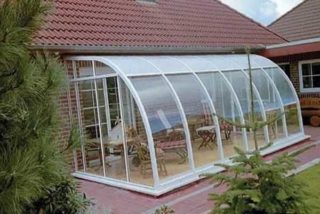
In terms of architecture, a polycarbonate veranda is a structure that is tightly adjacent to a residential building, a bathhouse or a summer kitchen. As a rule, it has two entrances - from the side of the street and from the main house. Unlike the polycarbonate terrace, the veranda is completely insulated from the environment by panels.
According to the method of design and implementation, polycarbonate verandas attached to the house are divided into the following categories:
- Built-in. They are being erected simultaneously with the house on a common support system. The walls of the building are partly the lateral parts of the extension. The glazing captures the fragments protruding outside the house, including the roof.
- Attached. A polycarbonate terrace joins the house at any stage, even after a few years. The structure has its own base, walls and roof. Docking with the house is not rigid, using insulating materials and decorative overlays.
When building a polycarbonate veranda, the project is tied to the foundation, style and size of the building. It is necessary to clarify with the managing authority about the need to agree on the planned changes in the architecture of the building.
Features and disadvantages of the material
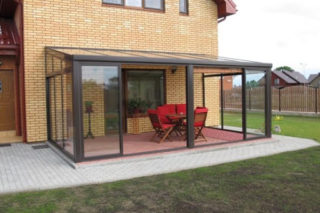
Polycarbonate and a terrace are an excellent combination of construction and its framing in all respects. The main practical and aesthetic function is performed by transparent panels. They are made of polycarbonate, which is based on carbon. The plastic contains substances that remain inert at any temperature.
The main advantages of polycarbonate:
- high impact strength;
- flexibility;
- lack of fragments when breaking;
- environmental Safety;
- small specific gravity;
- ease of processing;
- no need for finishing the veranda;
- excellent light transmission;
- wide range of colors and textures;
- low thermal conductivity.
Several manufacturers have started producing UV protection panels. It is performed using a protective film or by adding a special additive to the raw material for the production of granules.
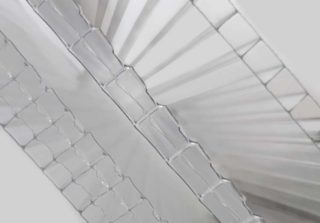
Disadvantages of the material:
- limited service life (up to 15 years);
- the presence of voids in which condensate accumulates, which over time leads to internal pollution;
- significant coefficient of thermal expansion;
- soft surface on which scuffs and scratches remain.
You can put up with such imperfections. The panels are relatively inexpensive. Replacing them periodically will not cause much hassle and large expenses.
Construction principles
When planning construction, you should think about a number of nuances that will affect the appearance, functionality of the room and the microclimate inside it. Initially, you should think about the shape of the roof. Its configuration determines the presentability of the structure and its resistance to wind and snow loads.
A polycarbonate veranda attached to the house can be equipped with a roof of this type:
- single slope;
- gable;
- pyramidal;
- dome;
- arched;
- concave;
- curved.
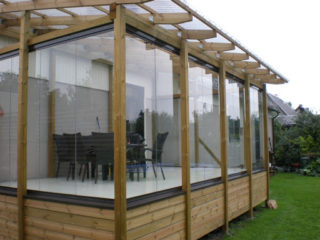
With regard to walls, it is worth staying on flat vertical surfaces with swing or sliding doors. It is better to make windows of the classic type, but vents should be provided in the upper part of the roof for ventilation. A terrace with a polycarbonate roof can have a fence made of wooden balusters, but it is advisable to choose a transparent version made of monolithic polycarbonate.
Separately, it is necessary to dwell on the manufacture of the frame and the rules for installing the panels.
You can make a frame from the following materials:
- Wood. Easy to process, easy to assemble, but only straight structures. It rots and deforms without regular impregnation.
- Galvanized iron. Differs in strength, reliability, but over time begins to rust.
- Corrosion-proof metal. An almost eternal option, but the price is quite high.
Particularly carefully you need to approach the installation of panels.
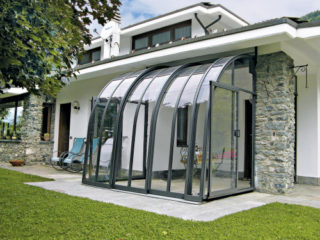
It is necessary to take into account the following nuances:
- They can bend only in one direction - along the longitudinal honeycomb, that is, along the length of the panels.
- The frame must be done so that the joints of the sheets fall on the bearing fragments.
- The connection of the slabs is carried out on a profile with a substrate and an upper bar.
- Screwing polycarbonate to the frame is carried out with special self-tapping screws with silicone thermal washers.
- Holes and joints are made with the expectation of thermal expansion of the panels, which is 3 mm per 1 m.
- The edges of the honeycomb boards are closed with perforated tape and end caps.
- Panels should be installed vertically or at an angle to ensure free drainage of condensate.
When choosing a tool for cutting polycarbonate, you need to choose products with low speeds, since the plastic heats up and melts from strong friction.
Advantages of terrace fencing
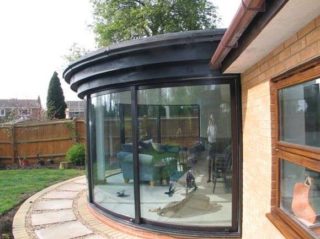
The decision to attach open spaces to houses and ancillary structures is very popular among private property owners. The presence of an open area under a canopy allows you to admire the surrounding landscapes and breathe fresh air without fear of getting wet in the rain and overheating in the sun. It is never too late to assemble the frame and sheathe it with polycarbonate, since there is already a base for modernizing the structure.
This decision is supported by the following considerations:
- Honeycomb panels have low thermal conductivity. With them, the room will be much warmer. Perhaps, even in winter, heating devices are not required.
- Plastic transmits infrared radiation, but blocks ultraviolet light. As a result, the object will warm up well, and the furniture and decoration will not be damaged.
- Transparent surfaces transmit light well. And this is a decrease in electricity costs, since the lamps will only turn on at night.
- On impact, the polymer does not form fragments. This factor is important when the extension is used as a playroom for children or a guest room.
- Heated air accumulating under the ceiling blocks cold streams, creating a comfortable microclimate in the room.
Lovers of fresh air can design and make a collapsible structure for themselves. The panels are easy to remove, and the frame is disassembled. A few hours of quiet work without significant effort is enough for dismantling.
The process of erecting a polycarbonate veranda with your own hands
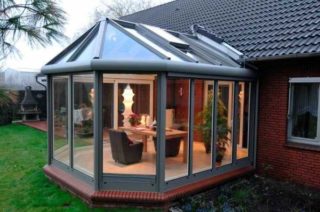
Before starting the glazing, the foundation on which the terrace is installed should be examined. It should be wide enough not to sag under the weight of the glazing and stable so that it will not be vomited out by a strong gust of wind. If there are wooden pillars or supports under the platform, it is better to replace them with screw piles, connect them with a grillage and fix the terrace on it. Such a solution will create an air gap under the extension, which will avoid the appearance of dampness and the development of mold in it.
Further actions should be carried out after assessing the condition of the roof and the fence, if it was installed earlier. If these structures are strong and fit the new design, they can be left. If not, everything except the support platform is dismantled.
Then the construction of a blank fence is carried out:
- Marking. Control measurements are made of the sides of the room, sawn to the required dimensions of the workpiece.
- Installation of the support profile. If a timber frame is selected, oak, larch or cedar timber is used. A layer of waterproofing is pre-laid. When working with metal, a guide profile is screwed to the floor.
- Installation of vertical supports. Here, the size of a standard polycarbonate sheet is taken into account. For a monolithic one, it is 105 × 205 cm, and for a honeycomb 70 × 210 cm.Since 205 and 210 cm are clearly not enough for a veranda, the height of the racks increases by 52 and 35/70 cm, respectively.
- Installation of crossbars. For a monolith, a distance equal to the height of the slab is quite sufficient. For cellular material, the optimal spacing is 105 cm.
- Installation of the upper strapping. It must be perfectly level to ensure the correctness of subsequent work.
- Assembling the roof frame. A rafter or arched system is made.
- Attach to sheet support elements.
- Installing carbonate sheets, securing planks, drainage tape and plugs.
The transparent coating should be periodically doused with water from a hose, and if it is heavily soiled, it should be washed with a sponge and dish detergent.









Poorly, he looked at information about polycarbonate since he messed up. I did not put it correctly, there is neither a substrate nor an upper bar at the joints. He only works with metal.